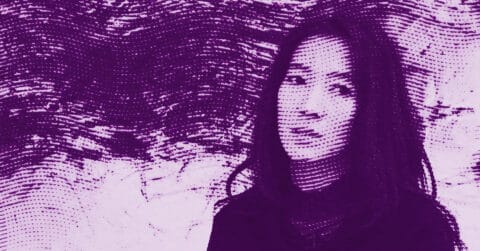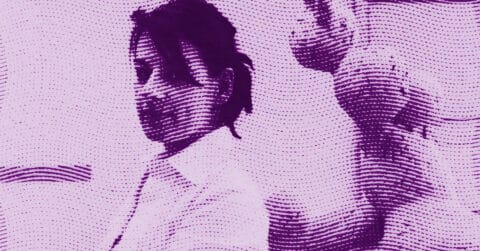Listen to me carefully, you bunch of snobs, if you think contemporary landscape has nothing more to tell us, it is because you have not yet encountered the astonishing work of Shara Hughes. This American artist, born in 1981 in Atlanta, achieved the feat of reinventing a genre many considered exhausted by creating parallel worlds that defy our conventional understanding of nature and representation.
While our era is saturated with repetitions and worn-out concepts, Hughes stands out for her ability to create works that transcend traditional categories. Her landscapes are not mere representations of existing places, but complex mental constructions that invite us to explore the uncharted territories of our psyche. Through her unique perspective, each painting becomes an open window into a world where the laws of physics and perception are rewritten according to a dreamlike logic.
Take for example her masterwork “The Delicate Gloom” (2018), which perfectly illustrates her ability to transform a simple floral motif into a profound meditation on the nature of consciousness. In this dizzying canvas, the colors seem to pulse with a life of their own, creating visual rhythms that resemble the beats of a cosmic heart. Deep purples mingle with acidic greens in a chromatic dance that evokes the borderline states of consciousness, those moments when objective reality dissolves into the flow of our subjective experience.
This singular approach to landscape finds a fascinating echo in the theories of perception developed by Maurice Merleau-Ponty in his “Phenomenology of Perception.” Just as the French philosopher suggested that our experience of the world is fundamentally embodied and subjective, Hughes creates landscapes that do not seek to represent an objective reality, but rather to capture the very essence of our perceptual experience. Her paintings do not show us how the world appears to a detached observer, but how it is lived from within, in the intimacy of our consciousness.
The way Hughes approaches color is particularly revealing of this phenomenological approach. In “What Nerve” (2024), she uses vivid blue dots adorning the branches of a tree as if they were eyes watching us. These touches of color are not merely decorative; they transform the tree into a conscious presence that looks at us as much as we look at it. This reciprocity of gaze, central to Merleau-Ponty’s thought, becomes here a structuring element of the composition.
The artist works without preparatory sketches, letting the painting guide her through a process reminiscent of Merleau-Ponty’s description of perception as a constant dialogue between the perceiving subject and the perceived world. Each brushstroke, every chromatic decision emerges from a direct interaction with the pictorial matter, creating forms that seem to spontaneously arise on the canvas, just as thoughts emerge in our consciousness.
In “Obstacles” (2019), Hughes pushes this exploration even further. The shadows of the trees become almost tangible presences that converse with the surrounding vegetation, creating a complex interplay between visible and invisible, between what is directly perceived and what is suggested. This work perfectly illustrates what Merleau-Ponty called the “flesh of the world,” that common texture that unites the perceiver and the perceived in the same sensitive fabric.
Hughes’ technique is as sophisticated as her vision is profound. She uses a variety of mediums, mixing oils, acrylics, and spray paints directly on the canvas. This multimedia approach creates textures and effects that enrich the visual complexity of her works. The drips, splashes, and spontaneous strokes are not mere stylistic effects but contribute to the creation of a pictorial space that reflects the dynamic and fluid nature of our perceptual experience.
In “Hot Coals” (2024), the central sun that seems to roast the surrounding vegetation creates a palpable tension between heat and destruction, between vitality and threat. This duality is not merely thematic, it is inscribed in the very material of the painting, where thick impastos contrast with more fluid areas, creating a surface that invites both touch and gaze.
The recent evolution of her work towards more vertical formats is particularly interesting. This unconventional orientation for traditional landscapes is not a mere formal choice, but a way to disrupt our usual relationship with the landscape. By favoring verticality, Hughes forces us to abandon our detached spectator position to engage in a more direct and embodied relationship with the work.
The treatment of flowers in her recent works reveals a new dimension of her research. In “My Natural Nyctinasty” (2021), a monumental flower closes its petals in a gesture that evokes both protection and imprisonment. This powerful image reminds us that our perception of the natural world is always colored by our own emotional states and psychological projections.
Her chromatic palette, which may seem intuitive at first glance, reveals a sophisticated understanding of the phenomenology of color. The combinations she creates are not arbitrary but serve to evoke specific perceptual experiences. A deep violet can suggest spatial depth while evoking an emotional state, while an electric yellow can create a sensation of immediate proximity.
In “Burn Out” (2024), Hughes explores the limits of our perception of heat through color. Spanning nearly three meters wide, she creates a symphony of reds and oranges that does not simply represent heat, but makes us feel it in an almost physical way. This ability to transform a thermal sensation into a visual experience perfectly illustrates the natural synesthesia of our perception that Merleau-Ponty considered fundamental.
Hughes’s approach to perspective is particularly revealing of her understanding of spatial perception. Her landscapes often present multiple simultaneous points of view, creating impossible spaces that defy our rational understanding. This multiplication of perspectives is not a mere formal game, but an exploration of the fundamentally ambiguous nature of our spatial experience.
In “Swelling” (2024), she creates a monumental wave that seems to unfold in multiple dimensions simultaneously. This work does not simply represent a wave, it captures the lived experience of facing an overwhelming natural force. The composition makes us physically feel dizziness and instability, illustrating how our perception of space is inseparable from our bodily experience.
The importance of emptiness in her compositions also deserves to be emphasized. The negative spaces in her works are never truly empty but vibrate with potential energy. In “Trust and Love” (2024), the space between two intertwined trees becomes an active presence that structures the entire composition. This treatment of emptiness recalls Merleau-Ponty’s conception of the invisible as an integral part of the visible.
The way Hughes treats borders and frames in her works is particularly significant. Often, she creates painted frames that enclose the main scene, creating a mise en abyme that invites us to question the very nature of perception and representation. These frames function as perceptual thresholds, passage points between different levels of reality.
Her creative process, which begins without a pre-established plan and develops organically, reflects the very nature of our perceptual engagement with the world. Each canvas becomes a journey of discovery, an exploration of the infinite possibilities of perception that gradually emerges through the act of painting.
In “I’m a Fan” (2024), she plays with our perception of movement through the depiction of palm trees stirred by the wind. The leaves that seem to ripple before our eyes are not simply shown in motion; they create a kinesthetic sensation that engages our entire body. This ability to transform a visual experience into a bodily sensation is at the heart of her practice.
Hughes’s landscapes are not merely places to contemplate, but active experiential spaces where the viewer is invited to engage their entire sensitive being. In “Float Along” (2024), the borders framing the composition create a portal effect that literally invites us to enter the painting’s space. This invitation to perceptual travel is characteristic of her approach, which never settles for mere representation.
Her recent series “Tree Farm” (2024) pushes this exploration of embodied perception even further. The trees she paints are not mere natural objects, but living presences that seem to breathe on the canvas. In “Wits End” (2024), a weeping willow with twisted branches becomes a metaphor for our own sensitive body, its ramifications evoking our nervous system.
The latest developments in her work also include an exploration of ceramics, where she transposes her unique vision into the third dimension. These sculptures, although new to her practice, naturally extend her research on embodied perception, offering the viewer an even more directly physical experience of her organic forms.
Shara Hughes has succeeded in creating a unique visual language that transcends the traditional boundaries of landscape to explore the very foundations of our perceptual experience. Her works do not merely depict the world; they invite us to perceive it anew, with a freshness and intensity that transform our understanding of what painting can be today. Her work reminds us that true artistic innovation does not lie in superficial novelty, but in the ability to renew our gaze upon the world and ourselves.
















